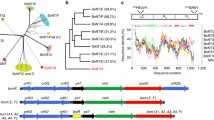Abstract
Botulinum Neurotoxin (BoNT) produced by the bacterium Clostridium botulinum as a complex with NAPs causes botulism. It has been known that the NAPs protect the toxin from both extremes of pHs and proteases of the GI tract. In an attempt to emulate the physiological conditions encountered by the toxin, we examined BoNT/A, BoNT/A complex, and NAPs under different pH conditions and monitored their structural characteristics by far-UV CD and thermal denaturation analysis. BoNT/A complex showed the maximum CD signal with a mean residue weight ellipticity of −1.8 × 105° cm2/dmol at 222 nm at both acidic and neutral pHs. Thermal denaturation analysis revealed NAPs to be the most stable amongst the three protein samples examined. Interestingly and quite uniquely, at pH 2.5, there was an increase in CD signal for BoNT complex as a function of temperature, which correlated with the NAPs profile, indicating a shielding effect of NAPs on BoNT complex at low pH. Calculation of the weighted mean of the ellipticities at the Tm for thermal unfolding of toxin and NAPs at neutral and acidic pHs showed variation with that of BoNT complex, suggesting structural reorganization in BoNT complex upon the association of NAPs and BoNT. In conclusion, this study reveals the structural behavior of BoNT complex and NAPs with pH changes substantially, which could be quite relevant for BoNT survival under extreme pH conditions in vivo.


Similar content being viewed by others
Abbreviations
- BoNT:
-
Botulinum Neurotoxin
- CD:
-
Circular Dichroism
- GI:
-
Gastrointestinal
- LD:
-
Lethal dose
- NAP:
-
Neurotoxin associated proteins
- UV:
-
Ultra violet
References
Cherington M (1998) Clinical spectrum of botulism. Muscle Nerve 21:701–710
Hatheway CL (1995) Botulism: the present status of the disease. Curr Top Microbiol Immunol 195:55–75
Gill DM (1982) Bacterial toxins: a table of lethal amounts. Microbiol Rev 46:86–94
Capek P, Dickerson TJ (2010) Sensing the deadliest toxin: technologies for botulinum neurotoxin detection. Toxins (Basel) 2:24–53
Ohishi I, Sugii S, Sakaguchi G (1977) Oral toxicities of Clostridium botulinum toxins in response to molecular size. Infect Immun 16:107–109
Sakaguchi G (1982) Clostridium botulinum toxins. Pharmacol Ther 19:165–194
Inoue K, Fujinaga Y, Watanabe T, Ohyama T, Takeshi K et al (1996) Molecular composition of Clostridium botulinum type A progenitor toxins. Infect Immun 64:1589–1594
Sugii S, Ohishi I, Sakaguchi G (1977) Correlation between oral toxicity and in vitro stability of Clostridium botulinum type A and B toxins of different molecular sizes. Infect Immun 16:910–914
Fujinaga Y, Inoue K, Watarai S, Sakaguchi Y, Arimitsu H et al (2004) Molecular characterization of binding subcomponents of Clostridium botulinum type C progenitor toxin for intestinal epithelial cells and erythrocytes. Microbiology 150:1529–1538
Fujinaga Y, Matsumura T, Jin Y, Takegahara Y, Sugawara Y (2009) A novel function of botulinum toxin-associated proteins: HA proteins disrupt intestinal epithelial barrier to increase toxin absorption. Toxicon 54:583–586
Gu S, Jin R (2013) Assembly and function of the botulinum neurotoxin progenitor complex. Curr Top Microbiol Immunol 364:21–44
Brandau DT, Joshi SB, Smalter AM, Kim S, Steadman B et al (2007) Stability of the Clostridium botulinum type A neurotoxin complex: an empirical phase diagram based approach. Mol Pharm 4:571–582
DasGupta BR, Sathyamoorthy V (1984) Purification and amino acid composition of type A botulinum neurotoxin. Toxicon 22:415–424
Yang JT, Wu CS, Martinez HM (1986) Calculation of protein conformation from circular dichroism. Methods Enzymol 130:208–269
Prell JS, Correra TC, Chang TM, Biles JA, Williams ER (2010) Entropy drives an attached water molecule from the C- to N-terminus on protonated proline. J Am Chem Soc 132:14733–14735
Kelly SM, Jess TJ, Price NC (2005) How to study proteins by circular dichroism. Biochim Biophys Acta 1751:119–139
Fu F-N, Sharma S, Singh B (1998) A protease-resistant novel hemagglutinin purified from type A Clostridium botulinum. J Protein Chem 17:53
Malizio CJ, Goodnough MC, Johnson EA (2000) Purification of Clostridium botulinum type A neurotoxin. Methods Mol Biol 145:27–39
Sathyamoorthy V, DasGupta BR (1985) Separation, purification, partial characterization and comparison of the heavy and light chains of botulinum neurotoxin types A, B, and E. J Biol Chem 260:10461–10466
Bryant AM, Davis J, Cai S, Singh BR (2013) Molecular composition and extinction coefficient of native botulinum neurotoxin complex produced by Clostridium botulinum hall A strain. Protein J 32:106–117
Sharma SK, Singh BR (1998) Hemagglutinin binding mediated protection of botulinum neurotoxin from proteolysis. J Nat Toxins 7:239–253
Cai S, Sarkar HK, Singh BR (1999) Enhancement of the endopeptidase activity of botulinum neurotoxin by its associated proteins and dithiothreitol. Biochemistry 38:6903–6910
Maksymowych AB, Simpson LL (2004) Structural features of the botulinum neurotoxin molecule that govern binding and transcytosis across polarized human intestinal epithelial cells. J Pharmacol Exp Ther 310:633–641
Lee K, Gu S, Jin L, Le TT, Cheng LW (2013) Structure of a bimodular botulinum neurotoxin complex provides insights into its oral toxicity. PLoS Pathog 9:e1003690
Acknowledgments
The authors would like to thank Steve Riding and Jenny Davis for preparing the different toxin proteins. This work was in part supported by a NIH Grant R03AI103868 and contract (HSHQDC-12-C-00071) from the Department of Homeland Security through Omni Array Biotechnology.
Conflict of interest
The authors declare that there are no conflicts of interest.
Ethical Standards
The experiments carried out in the study are in compliance with the current laws of the United States of America.
Author information
Authors and Affiliations
Corresponding author
Rights and permissions
About this article
Cite this article
Chellappan, G., Kumar, R., Cai, S. et al. Role of Neurotoxin Associated Proteins in the Low pH Induced Structural Changes in the Botulinum Neurotoxin Complex. Protein J 33, 557–564 (2014). https://doi.org/10.1007/s10930-014-9588-4
Published:
Issue Date:
DOI: https://doi.org/10.1007/s10930-014-9588-4




